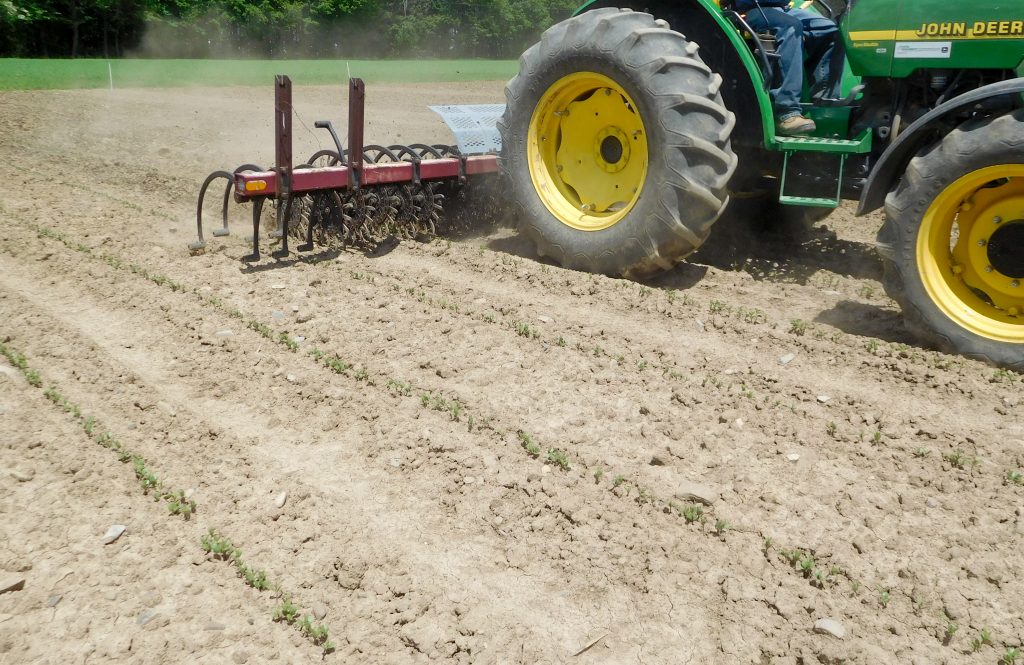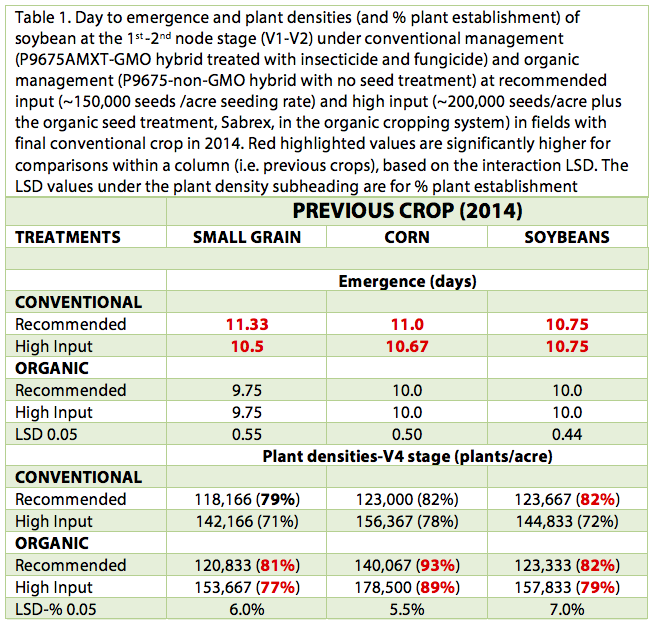Bill Cox1, Eric Sandsted1, Phil Atkins2, and RJ Richtmyer2
1Soil and Crop Sciences Section; 2New York Seed Improvement Project, Plant Breeding and Genetics Section – School of Integrative Plant Science, Cornell University

We initiated a 3-year study at the Aurora Research Farm in 2015 to compare different sequences of the corn, soybean, and wheat/red clover rotation in conventional and organic cropping systems under recommended and high input management during the 3-year transition period (2015-2017) from conventional to an organic cropping system. We provided a detailed discussion of the various treatments and objectives of the study in a previous soybean article (https://blogs.cornell.edu/whatscroppingup/2015/09/16/emergence-early-v2-stage-plant-populations-and-weed-densities-r4-in-soybeans-under-conventional-and-organic-cropping-systems/). This article will focus on soybean emergence (days), and early plant densities (% early plant establishment) at the 1st to 2nd node (V1-2 stage) in 2017.
Corn preceded soybean in the rotation in this study. The fields were plowed on May 17 and then cultimulched on the morning of May 18, the day of planting. We used the White Air Seeder to plant the treated (insecticide/fungicide) GMO soybean variety, P22T41R2, and the non-treated non-GMO variety, 92Y21, at two seeding rates, ~150,000 (recommended input) and ~200,000 seeds/acre (high input). Unlike the corn comparison, P96Y21 is a not an isoline of P22T41R2 so only the maturity of the two varieties and not the genetics are similar between the two cropping systems. As with corn, we treated the non-GMO, 92Y21, in the seed hopper with the organic seed treatment, Sabrex, in the high input treatment (high seeding rate). Unlike corn, however, we used different row spacing in the two cropping systems with the typical 15” row spacing in the conventional cropping system and the typical 30” row spacing (for cultivation of weeds) in the organic cropping system. Consequently, the soybean comparison is not as robust as the corn comparison for emergence and early plant establishment because of the different row spacing and genetics between the two cropping systems.
Wet and cool conditions (59o F average temperature and 2.0 inches of precipitation) in the 10 days following planting resulted in relatively slow emergence and plant establishment, especially in conventional soybean. Organic soybean required about 10 days for emergence but conventional soybean required about 11 days (Table 1). The more rapid soybean emergence in the organic system is similar to 2015 (https://blogs.cornell.edu/whatscroppingup/2015/06/16/days-to-emergence-and-early-corn-and-soybean-plant-populations-under-conventional-and-organic-cropping-systems/) and 2016 results (https://blogs.cornell.edu/whatscroppingup/2016/07/28/emergence-plant-densities-v2-stage-and-weed-densities-r3-stage-of-soybean-in-conventional-and-organic-cropping-systems-in-2016/). As in previous years, variety differences rather than cropping system differences probably influenced days to emergence. Pioneer rated P92Y21, the variety used in the organic system, with a higher field emergence score (8 out of 10 rating) compared with P22T41R2 (7 out of 10), which probably contributed to the more rapid emergence in the organic system. The organic cropping system also was planted in 30 inch rows so there were 8.5 or 11.5 seeds emerging through the developing soil crust in 1 foot of row in the organic system compared with 4.25 or 5.75 seeds emerging in 1 foot of row in the conventional system. Days to emergence did not differ between the recommended and high input treatments in the organic cropping system, indicating that Sabrex, the organic seed treatment, did not hasten soybean emergence in 2017, similar to results in 2015 and 2016.
We estimated soybean plant densities at the V1-2 stage (June 2), a few hours before the rotary hoeing operation in organic soybean. Organic soybean generally had higher plant establishment rates (77% to 93%) compared with conventional soybean (71 to 82%, Table 1). Differences were more pronounced between cropping systems in the high input treatment for reasons that are unclear. We will estimate soybean densities again before the close cultivation in soybean to determine if rotary hoeing reduced soybean populations. We did not see much visual damage to soybean plants after rotary hoeing. In fact, it is conceivable that populations may increase because the rotary hoe broke the developing soil crust that had formed after the numerous heavy rain showers after planting.
Early plant populations in all treatments exceed the 114,000 threshold limit for maximum soybean yields in NY so organic and conventional soybean have similar yield potential at the V1-2 stage. Adequate control of weeds in the organic soybean will thus be the main factor in determining yield differences between organic and conventional soybeans, provided aphid infestation and/or disease incidence does not occur.













